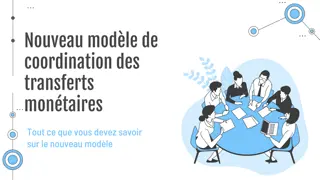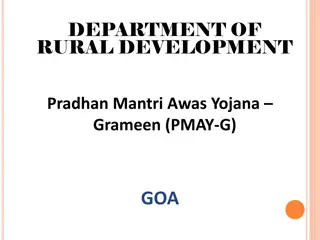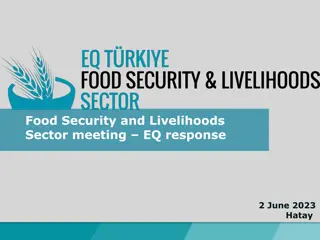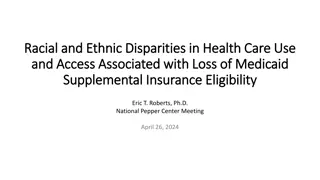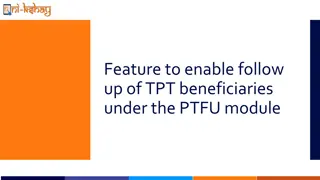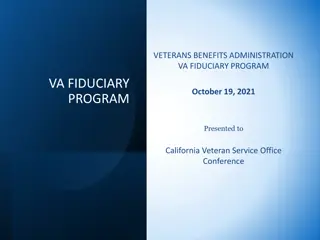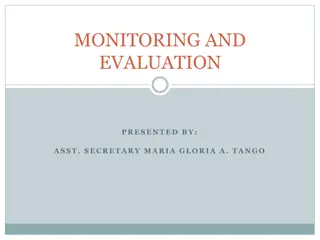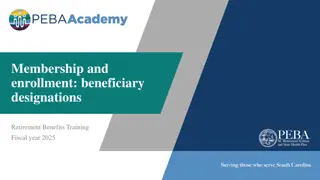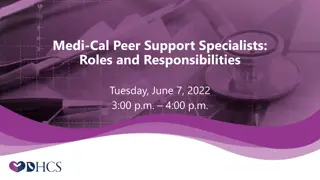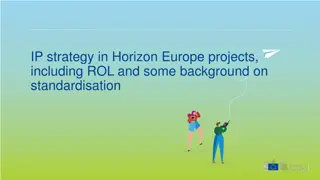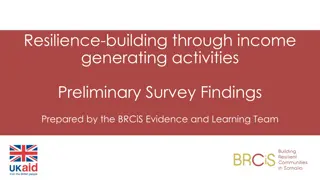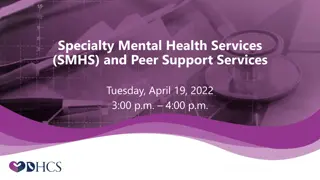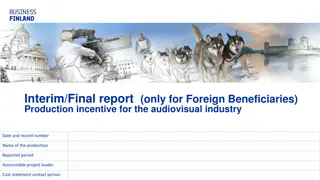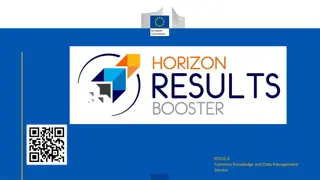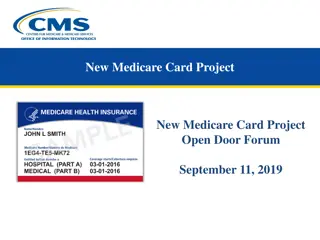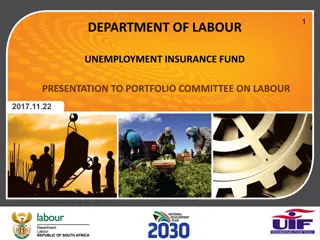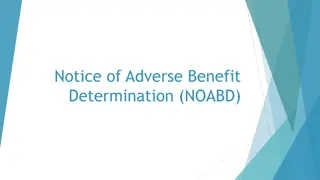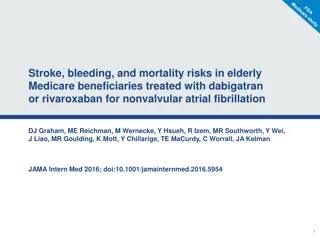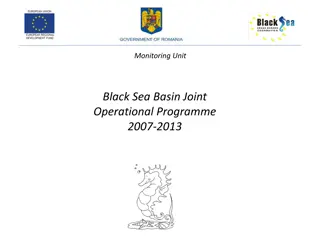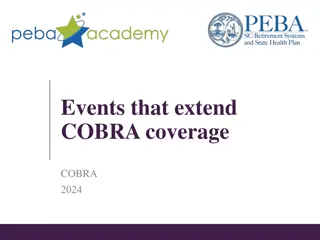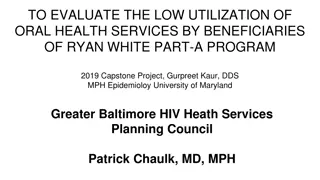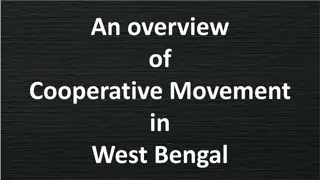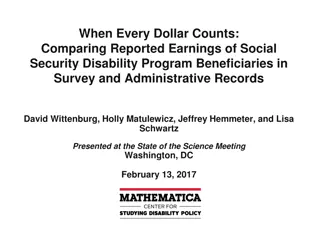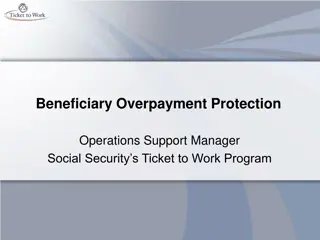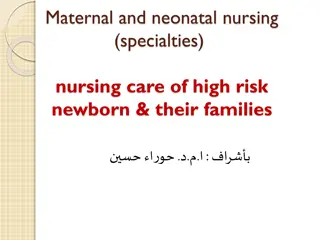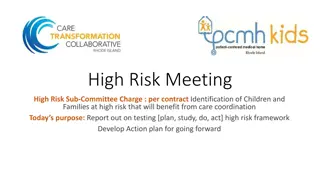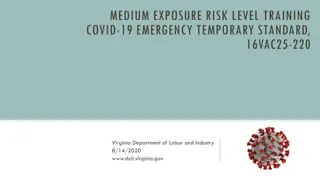Benefits of Coordinating Monetary Transfers for Beneficiaries
Coordinating monetary transfers provides various advantages for beneficiaries, including scalability, increased resources, speed, reduced duplication, improved targeting, better referral networks, enhanced links with social protection systems, improved communication, and harmonized approaches. This
4 views • 16 slides
Understanding Risk Management in Environmental Geography and Disaster Management
Risk management in environmental geography and disaster management involves assessing the potential losses from hazards, evaluating vulnerability and exposure, and implementing strategies to mitigate risks. It includes calculating risk, dealing with risk through acceptance, avoidance, reduction, or
1 views • 10 slides
Treatment Supporter Scheme for Tuberculosis Preventive Treatment Beneficiaries
Treatment Supporter Scheme provides assistance to TPT beneficiaries in completing their treatment. Treatment Supporters can be various individuals including Medical Officers, MPWs, and community volunteers. Their role involves educating beneficiaries about TPT treatment, ensuring medication adherenc
1 views • 21 slides
Pradhan Mantri Awas Yojana Grameen (PMAY-G) in Goa
Pradhan Mantri Awas Yojana Grameen (PMAY-G) is a housing scheme launched in Goa aiming to provide assistance to rural families for constructing houses. Beneficiaries are selected based on the Socio Economic Caste Census 2011. The scheme offers financial aid of Rs. 1,20,000 per house. Challenges face
0 views • 8 slides
Can Medicare Beneficiaries Afford Their Health Care? Findings from Commonwealth Fund 2023
Americans with Medicare face challenges affording health care, with many struggling to pay for essential health services. The Commonwealth Fund 2023 survey reveals that a significant portion of Medicare beneficiaries find it difficult to afford health care costs, leading to delays in necessary care
1 views • 10 slides
Food Security and Livelihoods Sector Meeting Response in Hatay
The Food Security and Livelihoods Sector meeting in Hatay covered various important topics such as action points, partner updates, 5W data analysis, and weekly reporting on assistance provided to beneficiaries. The meeting agenda included discussions on hot meal arrangements, coordination of agricul
1 views • 9 slides
Understanding Racial and Ethnic Disparities in Health Care Utilization and Access
This presentation explores disparities in health care access among Medicare beneficiaries, focusing on the impact of loss of Medicaid and supplemental insurance eligibility. It discusses the challenges faced by Black and Hispanic individuals above the Medicaid cutoff, their lower likelihood of havin
1 views • 12 slides
Efficient Management of TPT Beneficiaries with Post-Treatment Follow-Up Module
As part of the TOG 2016 guidance, beneficiaries completing treatment are eligible for a 2-year follow-up in the PTFU module. Ni-kshay facilitates identifying and managing eligible beneficiaries, capturing follow-up details, and generating reports for further actions. The system allows tracking of TP
0 views • 22 slides
VA Fiduciary Program Overview
The Veterans Benefits Administration's Fiduciary Program aims to provide oversight for vulnerable beneficiaries who are unable to manage their VA benefits. The program involves a competency determination process, including medical opinions and court determinations, to ensure the proper appointment o
0 views • 25 slides
Effective Monitoring and Evaluation Practices in Program Management
Asst. Secretary Maria Gloria A. Tango presents on the importance of setting up Monitoring and Evaluation (M&E) systems, showcasing practices, challenges, and opportunities in the M&E process. The presentation highlights the roles of central offices, regional offices, and the Institute of Labor Studi
0 views • 9 slides
Understanding Beneficiary Designations for Retirement Benefits
Explore the process of beneficiary designations for retirement benefits, including options for active members and the importance of naming beneficiaries. Learn about primary and contingent beneficiaries, potential benefits, and the significance of proper documentation. Ensure a smooth transition of
1 views • 6 slides
Peer Support Specialists: Roles and Responsibilities in Medi-Cal
Medi-Cal is preparing for the end of the COVID-19 Public Health Emergency and urging beneficiaries to update their contact information to maintain coverage. DHCS is introducing peer support specialist services as an optional behavioral health benefit in California from July 1, 2022, onwards. Become
2 views • 36 slides
Intellectual Property Management in Horizon Europe Projects
Horizon Europe projects require beneficiaries to implement comprehensive strategies for managing intellectual property. This includes protecting and exploiting project results, providing a Results Ownership List (ROL), and considering freedom to operate and publication vs. IP protection balance. Fai
0 views • 10 slides
Preliminary Survey Findings on Resilience-building through Income Generating Activities
Survey findings from the BRCiS Evidence and Learning Team show positive impacts of income generating activities in Somalia. The intervention led to increased private businesses, higher incomes, improved savings, and reduced debt among beneficiaries. The majority of businesses are still running post-
1 views • 22 slides
Mental Health and Peer Support Services Event
Join Specialty Mental Health Services (SMHS) and Peer Support Services on Tuesday, April 19, 2022, from 3:00 p.m. to 4:00 p.m. for valuable insights and strategies. Discover the importance of DHCS programs in ensuring coverage continuity for millions of beneficiaries. Learn how to become a DHCS Cove
2 views • 23 slides
Foreign Beneficiaries Production Incentive Report
This report template is specifically for foreign beneficiaries receiving production incentives in the audiovisual industry. It guides them on reporting details, cost breakdowns, implementation evaluation, statistics on Finnish employees involved, sustainability practices, and a statement from the pr
0 views • 8 slides
Project Risk Management Fundamentals: A Comprehensive Overview
Project risk management involves minimizing potential risks and maximizing opportunities through processes such as risk management planning, risk identification, qualitative and quantitative risk analysis, risk response planning, and risk monitoring and control. Quantitative risk analysis assesses t
0 views • 41 slides
Horizon Results Booster - Maximizing Impact for Research & Innovation Projects
The Horizon Results Booster, a service offered by the European Commission, aims to boost the impact of Research & Innovation projects by helping beneficiaries better disseminate and valorize their results, increase exploitation potential, improve access to the market, and implement effective dissemi
0 views • 4 slides
Important Updates on the New Medicare Card Project
The New Medicare Card Project is nearing completion, with significant changes coming into effect from January 1, 2020. Beneficiaries are advised to use their new Medicare cards, protect their Medicare number, and take necessary steps to ensure smooth transitions. Key points reinforce the importance
0 views • 19 slides
Labour Activation Fund Presentation to Portfolio Committee on Labour
Department of Labour's Unemployment Insurance Fund presentation outlines initiatives to upskill and reintegrate beneficiaries into the job market. The Labour Activation Programme focuses on poverty alleviation, enhancing employability, and supporting beneficiaries through training schemes. The Fund
6 views • 24 slides
Understanding the Notice of Adverse Benefit Determination (NOABD)
The Notice of Adverse Benefit Determination (NOABD) is a crucial document that informs Medi-Cal beneficiaries about decisions regarding their services. It outlines what actions were taken, reasons behind those actions, the beneficiaries' rights, and what they can do next. This notice must be provide
0 views • 26 slides
Comparing Bleeding and Mortality Risks of Dabigatran vs. Rivaroxaban in Elderly Medicare Beneficiaries
A study by DJ Graham et al. compared the risks of stroke, bleeding, and mortality in elderly Medicare beneficiaries with nonvalvular atrial fibrillation treated with dabigatran or rivaroxaban. The study included over 118,000 patients and found that dabigatran was associated with a lower risk of majo
0 views • 9 slides
Responsibilities and Monitoring Procedures in Black Sea Basin Programme
The Monitoring Unit in the Black Sea Basin Joint Operational Programme outlines the responsibilities of beneficiaries, lead partners, and other partners. Beneficiaries are required to ensure project implementation, document management, financial reporting, and grant distribution. Partners must coope
0 views • 21 slides
Understanding COBRA Coverage Extension Events and Qualifying Criteria
This overview provides crucial information on events that extend COBRA coverage, types of qualifying events, and the process to extend coverage to 29 months. COBRA allows qualified beneficiaries to extend coverage under certain circumstances, such as Social Security disability approval, death of the
0 views • 12 slides
Evaluation of Oral Health Services Utilization Among Ryan White Part-A Beneficiaries
Gurpreet Kaur, DDS, MPH, and the Greater Baltimore HIV Health Services Planning Council conducted a 2019 capstone project to assess low utilization of oral health services by Ryan White Part-A program beneficiaries. Consequences of poor dental health, impact of HIV on oral health, data collection me
1 views • 16 slides
Understanding Risk Concepts and Management Strategies in Finance
Explore the essential concepts of risk in finance, such as risk definition, risk profiles, financial exposure, and types of financial risks. Learn about risk vs. reward trade-offs, identifying risk profiles, and tools to control financial risk. Understand the balance between risk and return, and the
0 views • 18 slides
Risk and Return Assessment in Financial Management
This comprehensive presentation explores the intricacies of risk and return assessment in the realm of financial management. Delve into understanding risk concepts, measuring risk and return, major risk categories, and the impact of risk aversion on investment decisions. Gain insights into the manag
0 views • 62 slides
Risk Management and Security Controls in Research Computing
The European Grid Infrastructure (EGI) Foundation conducts risk assessments and implements security controls in collaboration with the EOSC-hub project. The risk assessments involve evaluating threats, determining likelihood and impact, and recommending treatment for high-risk threats. Results from
0 views • 13 slides
Risk Management & MPTF Portfolio Analysis at Programme Level for UN Somalia
This session delves into the world of risk management and portfolio analysis at the programme/project level, specifically focusing on the Risk Management Unit of the United Nations Somalia. It covers enterprise risk management standards, planned risk management actions, the role of RMU, joint risk m
0 views • 30 slides
Alcohol and Cancer Risk: Understanding the Links
Alcohol consumption is linked to an increased risk of various cancers, including mouth, throat, esophagus, breast, liver, and colorectal cancers. Factors such as ethanol, acetaldehyde, nutrient absorption, estrogen levels, and liver cirrhosis play a role in this risk. Even light drinking can elevate
0 views • 17 slides
Unique Characteristics of Louisiana Trusts: Vested Beneficiaries and Substitutions
Louisiana trust laws have unique characteristics regarding vested beneficiaries and substitutions upon a principal beneficiary's death. The state's civil law tradition influences trust principles, emphasizing heritability and ascertainability of beneficiaries. Specific statutes govern these aspects,
0 views • 44 slides
Cooperative Movement in West Bengal: A Comprehensive Overview
This overview delves into the cooperative movement in West Bengal, highlighting key statistics such as the number of cooperative societies, members, PACS, and banks. It also covers aspects like enrolment of new members, crop loans disbursed, beneficiaries of crop loans, and issuance of medium to lon
0 views • 15 slides
Comparing Employment and Earnings Data of Social Security Disability Program Beneficiaries
This study compares reported earnings of Social Security Disability Program beneficiaries in survey and administrative records. The research highlights differences in employment rates and earnings estimates between the two data sources and aims to identify demographic and impairment subgroup variati
0 views • 19 slides
Understanding Beneficiary Overpayments in Social Security Programs
Exploring the concepts of beneficiary overpayment, this informative content delves into how overpayments occur for SSI and SSDI beneficiaries, steps to notify beneficiaries, their rights for reconsideration or waiver, and tips to avoid overpayments. It covers excess income and resources, ways overpa
0 views • 37 slides
Foreign Beneficiaries Production Incentive Report
Instructions and guidelines for foreign beneficiaries seeking production incentives in the audiovisual industry from Business Finland. The report includes sections on reporting, cost statements, implementation details, statistics, and sustainability practices. It outlines the required processes for
0 views • 8 slides
High-Risk Newborn Nursing Care and Factors
Maternal and neonatal nursing specialties focus on providing care for high-risk newborns and their families, who face conditions endangering the neonate's survival. Factors contributing to high-risk newborns include high-risk pregnancies, maternal medical illnesses like diabetes, labor complications
0 views • 25 slides
Developing a Risk Appetite Culture: Importance and Framework
Risk management plays a critical role in the success of corporations, with strategy and risk being intertwined. This presentation delves into definitions of key terms such as risk appetite, the Risk Appetite Cycle, characteristics of a well-defined risk appetite, and the importance of expressing ris
0 views • 31 slides
Security Planning and Risk Management Overview
This content provides an in-depth exploration of managing risk, security planning, and risk appetite in the context of cybersecurity. It covers essential concepts such as risk management process, threat types, risk analysis strategies, vulnerability assessment, and risk mitigation techniques. The ma
0 views • 73 slides
High-Risk Meeting: Identification and Care Coordination for Vulnerable Children and Families
The high-risk sub-committee is tasked with identifying children and families at high risk and developing a care coordination plan for their benefit. The meeting agenda includes reviewing the high-risk framework, discussing results and impacts, reflecting on successes and challenges, setting meeting
0 views • 12 slides
Workplace Exposure Risk Levels Training and Standards Overview
This content provides detailed information on exposure risk levels in the workplace, including medium, low, high, and very high risk classifications. It explains the requirements and training needed for each risk level, as well as how to determine exposure risk levels based on tasks, work environmen
0 views • 25 slides
